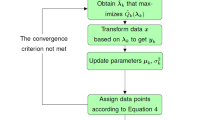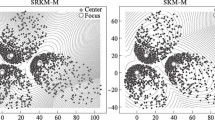Abstract
We present a new clustering procedure called K-midranges clustering. K-midranges is analogous to the traditional K-Means procedure for clustering interval scale data. The K-midranges procedure explicitly optimizes a loss function based on the L∞, norm (defined as the limit of an Lp norm as p approaches infinity).
Access this chapter
Tax calculation will be finalised at checkout
Purchases are for personal use only
Preview
Unable to display preview. Download preview PDF.
Similar content being viewed by others
References
Carroll, J. D., & Chaturvedi, A. D. (1995). A General Approach to Clustering and Multidimensional Scaling of Two-way, Three-way, or Higher-way Data, in Geometric Representations of Perceptual Phenomena: Papers in Honor of Tarow Indow’s 70th Birthday. Luce, R. D., D’Zmura, M., Hoffman, D. D., Iverson, G., & Romney, A. K. (Eds.), Lawrence Erlbaum, 295 - 318.
Chaturvedi, A. D., Carroll, J. D., Green, P., and Rotondo, J. A. (1997). A Feature based Approach to Market Segmentation via Overlapping K-centroids Clustering. Journal of Marketing Research, 34, 370–377
Chaturvedi, A. D., Paul E. Green, and J. Douglas Carroll (1996). Market Segmentation via K-modes clustering. Invited paper presented at the American Statistical Association conference held in Chicago.
Hartigan, J. A. (1975). Clustering Algorithms, Wiley, New York.
Hubert, L., & Phipps Arabie (1985). Comparing Partitions. Journal of Classification, 2, 193–218.
Jain, A. K. & Richard C. Dubes (1988), Algorithms for Clustering Data, Prentice- Hall, New Jersey.
Kaufman, L. & Peter J. Rousseeuw (1989). Finding Groups in Data: An Introduction to Cluster Analysis, Wiley, New York.
MacQueen, J. B. (1967). Some Methods for Classification and Analysis of Multivariate Observations, in Proceedings of the Fifth Berkeley Symposium on Mathematical Statistics and Probability. LeCam, L. M., & Neyman, J. (Eds.), 1, 281–297.
Mirkin, J. B. (1990). A Sequential Fitting Procedure for Linear Data Analysis Models. Journal of Classification, 7, 167–195.
Vinod, H. D. (1969). Integer Programming and Theory of Grouping. Journal of the American Statistical Association, 64, 506–519.
Author information
Authors and Affiliations
Editor information
Editors and Affiliations
Rights and permissions
Copyright information
© 1998 Springer-Verlag Berlin · Heidelberg
About this paper
Cite this paper
Carroll, J.D., Chaturvedi, A. (1998). K-midranges clustering. In: Rizzi, A., Vichi, M., Bock, HH. (eds) Advances in Data Science and Classification. Studies in Classification, Data Analysis, and Knowledge Organization. Springer, Berlin, Heidelberg. https://doi.org/10.1007/978-3-642-72253-0_1
Download citation
DOI: https://doi.org/10.1007/978-3-642-72253-0_1
Publisher Name: Springer, Berlin, Heidelberg
Print ISBN: 978-3-540-64641-9
Online ISBN: 978-3-642-72253-0
eBook Packages: Springer Book Archive




